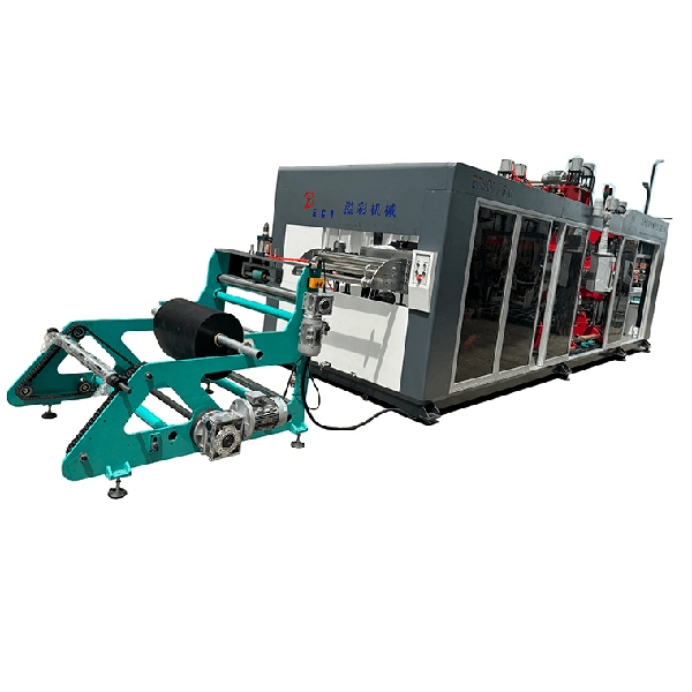
A plastic thermoforming machine is a vital piece of industrial equipment used to shape plastic materials into desired forms through the process of heating and forming. This technology is widely utilized in packaging, automotive components, disposable items, and household products. The growing demand for cost-effective, customizable, and lightweight plastic products has propelled plastic thermoforming machines into the spotlight, making them a critical asset in various manufacturing industries.
Understanding the main components of a plastic thermoforming machine is essential for manufacturers, engineers, and technical operators. Knowing how each part contributes to the overall process allows for better operation, maintenance, and troubleshooting. This article provides a comprehensive breakdown of the major parts of a plastic thermoforming machine, including the electronic control part, institutional part, and oil pressure part. It also includes practical insights, product comparisons, and helpful FAQs to address common user concerns.

Electronic Control Part
The electronic control part is the brain of a plastic thermoforming machine, responsible for regulating the entire forming process with precision and consistency. Modern machines are equipped with advanced control systems that offer automation, data logging, remote diagnostics, and user-friendly interfaces.
Key Components of the Electronic Control Part
| Component | Function |
| PLC (Programmable Logic Controller) | Coordinates the sequence of operations and controls timing for each phase of the forming cycle. |
| HMI (Human Machine Interface) | Provides operators with a touchscreen interface to configure settings, monitor performance, and diagnose faults. |
| Temperature Controllers | Precisely manage the heating zones to ensure optimal forming temperature of plastic sheets. |
| Servo Controllers | Control the movement and positioning of motors and actuators for precision forming. |
| Sensor Systems | Include thermocouples, proximity sensors, and load cells for feedback control and safety monitoring. |
Features and Benefits
Automation: Modern plastic thermoforming machines can be fully automated to reduce human error and increase repeatability.
Energy Efficiency: Advanced controllers optimize energy usage during heating and cooling phases.
Remote Monitoring: IoT integration allows engineers to track performance and diagnose issues remotely.
Safety: Integrated sensors halt operations during malfunctions, protecting the machine and operators.
Comparative Analysis: PLC vs Traditional Control
| Feature | PLC | Traditional Control |
| Flexibility | High (Programmable) | Low (Fixed Logic) |
| Upgradeability | Easy | Difficult |
| User Interface | Modern HMI | Basic switches or dials |
| Diagnostics | Advanced | Limited |
The electronic control part ensures that the plastic thermoforming machine operates with accuracy, reliability, and efficiency—critical factors for maintaining consistent product quality.
Institutional Part
The institutional part, also known as the mechanical structure, is the backbone of a plastic thermoforming machine. It includes all the mechanical assemblies that physically manipulate the plastic sheet during the forming process.
Key Structural Assemblies
| Component | Function |
| Heating System | Uses radiant or contact heaters to raise the plastic sheet to its forming temperature. |
| Clamping Frame | Holds the plastic sheet securely in place during heating and forming. |
| Forming Molds | Shape the heated plastic using vacuum, pressure, or mechanical force. |
| Sheet Feeding System | Moves plastic sheets into the heating and forming station. |
| Cutting Station | Trims the final formed product from the excess plastic sheet. |
Types of Forming Techniques Supported
Vacuum Forming: Utilizes vacuum suction to pull heated plastic over the mold surface.
Pressure Forming: Combines vacuum and high-pressure air to improve detail and definition.
Mechanical Forming: Uses mechanical plugs or tools to pre-stretch and form the plastic.
Engineering Design Considerations
Precision Alignment: Ensures consistent mold engagement and reduces wear and tear.
Material Durability: Frames and moving parts are typically made of stainless steel or high-strength aluminum.
Modular Construction: Facilitates maintenance and future upgrades.
Example: Heating System Specifications
| Parameter | Typical Value |
| Heating Element Type | Quartz infrared or ceramic |
| Heating Time | 10–30 seconds |
| Temperature Range | 100°C – 400°C |
| Zoning | Multi-zone for uniform heating |
A well-designed institutional part ensures structural integrity and consistent product output. This is where raw plastic sheets are transformed into usable goods, making it a critical aspect of any plastic thermoforming machine.
Oil Pressure Part
The oil pressure part or hydraulic system in a plastic thermoforming machine provides the force required for various mechanical operations such as clamping, lifting, and mold movement. This system plays a pivotal role in ensuring that high-pressure forming processes are carried out smoothly and efficiently.
Main Components of the Oil Pressure System
| Component | Function |
| Hydraulic Pump | Generates pressurized fluid to drive actuators and cylinders. |
| Hydraulic Cylinder | Converts hydraulic pressure into linear mechanical force. |
| Directional Valves | Control the flow direction of hydraulic fluid. |
| Pressure Relief Valves | Maintain system pressure within safe limits. |
| Oil Cooler | Regulates the temperature of the hydraulic oil. |
Advantages of Hydraulic Systems
High Force Output: Essential for deep-draw or high-strength forming applications.
Smooth Operation: Hydraulic actuators provide fluid, controlled movements.
Load Holding Capability: Hydraulic systems can hold molds in place without fluctuation.
Maintenance Checklist for Hydraulic Systems
| Task | Frequency |
| Oil level check | Weekly |
| Filter replacement | Monthly |
| Leak inspection | Weekly |
| Pressure calibration | Quarterly |
Comparison: Hydraulic vs Pneumatic vs Servo Systems
| Feature | Hydraulic | Pneumatic | Servo |
| Force Capability | High | Low–Medium | Medium |
| Precision | Medium | Low | High |
| Energy Efficiency | Medium | High | High |
| Maintenance Needs | Moderate–High | Low | Low |
The oil pressure part is especially important in large, industrial-grade plastic thermoforming machines where forming larger, thicker sheets demands higher force and precision.
Conclusion
In summary, a plastic thermoforming machine is an intricate combination of electrical, mechanical, and hydraulic systems. Each part plays a unique and essential role in shaping plastic sheets into high-quality finished products. The electronic control part brings intelligence and automation to the process. The institutional part provides the mechanical structure and tools necessary for heating, forming, and cutting. Lastly, the oil pressure part ensures sufficient power and precision for forming operations.
As manufacturing trends move toward increased customization, speed, and sustainability, innovations in plastic thermoforming machines continue to emerge. Smart controls, modular designs, and energy-efficient systems are becoming industry standards. For businesses that rely on plastic packaging, consumer goods, or custom industrial parts, investing in a high-performance plastic thermoforming machine and understanding its components is crucial for long-term productivity and success.
FAQs
What is the function of a plastic thermoforming machine?
A plastic thermoforming machine heats plastic sheets to a pliable temperature and forms them into shapes using molds and mechanical force. It's widely used in packaging, automotive, and consumer product manufacturing.
How many main parts does a plastic thermoforming machine have?
Typically, the machine consists of three main parts: electronic control, institutional, and oil pressure systems, each handling logic, mechanical movement, and power respectively.
What type of plastic can be used in thermoforming?
Common thermoforming materials include ABS, PVC, PET, HIPS, and polypropylene, depending on the desired strength, flexibility, and clarity of the final product.
How does the oil pressure system improve forming quality?
The oil pressure system ensures consistent and powerful forming action, which is especially critical when producing deep-draw or thick-walled products.
Can a thermoforming machine be integrated into a production line?
Yes, most modern plastic thermoforming machines are designed to be integrated with feeding units, trimming stations, and robotic arms for fully automated production lines.
What is the lifespan of a plastic thermoforming machine?
With regular maintenance, a plastic thermoforming machine can operate efficiently for 10–20 years, depending on usage intensity and environmental conditions.
How often should the hydraulic oil be replaced?
Hydraulic oil should typically be replaced every 2,000 to 4,000 operating hours, or as specified by the manufacturer. Regular monitoring is recommended to maintain system performance.
What safety features are included in modern machines?
Modern machines include emergency stop buttons, sensor-based fault detection, automatic shut-off, and thermal overload protection as standard features.
What is the difference between vacuum forming and pressure forming?
Vacuum forming relies on negative pressure (suction), while pressure forming combines vacuum and positive air pressure to achieve finer detail and more complex shapes.
















